Missi Roti
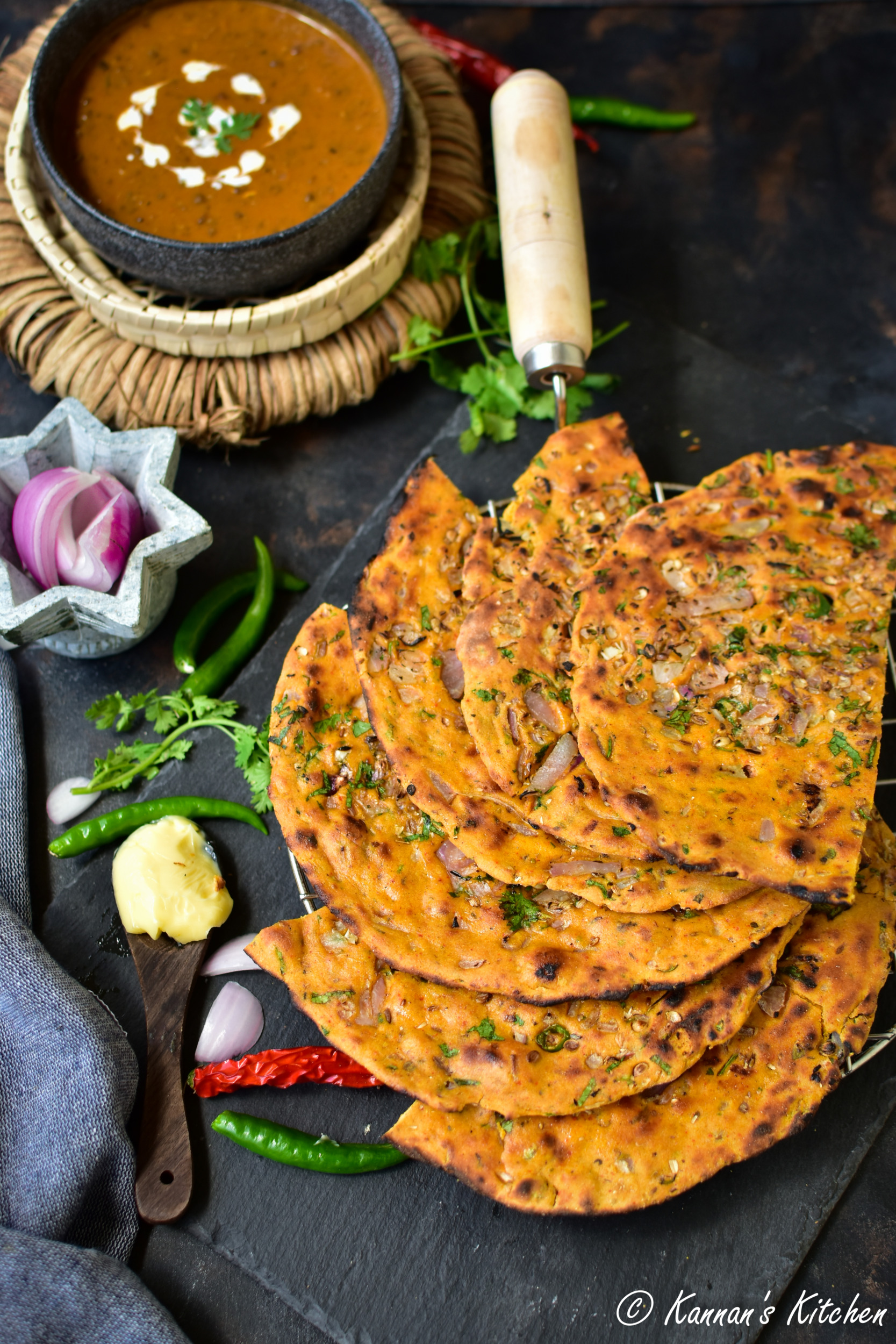
Roti is a staple carbohydrate in Indian food and one of the most commonly eaten flatbread in North India. Though roti or chapati that is made with whole wheat flour is the most common form of flat bread consumed in the household, but there are numerous variations like Naan, Tandoori Roti, Kulcha etc. One such popular roti in North India is Missi Roti. Missi Roti is especially popular in Punjabi restaurants and Dhabas.
Missi Roti is my personal favourite and a regular pick whenever I order dal makhani in restaurants. I make this roti quite often during the winters as it is quite comforting too. This roti pairs very well with most North Indian gravies and lentils like dal makhani. This is a very flavourful roti and also tastes great by itself when smeared with some ghee and butter and served with a pickle.
What is Missi Roti?
Missi Roti is a flatbread made with a blend of gram flour (Besan) and Whole wheat flour, mixed with spices and onions. In terms of the spices, roughly crushed Carom seeds or Ajwain, coriander seeds and cumin are some of the important whole spices that are added to Missi roti which gives it a wonderful aroma and taste. Similarly, a generous amount of chopped onions is added to this roti which enhances the taste and also gives a good crunch to the roti.
Gram flour is relatively high in protein content as compared to whole wheat flour, hence this roti is a great choice for weight reduction. Missi roti also keeps you full for a longer amount of time.
Unlike other rotis, missi roti has a slightly coarser and crunchy texture. It is very easy to get the texture wrong with some simple mistakes. Let us look at some of the common issues encountered while making missi roti and my tips to avoid or overcome them.
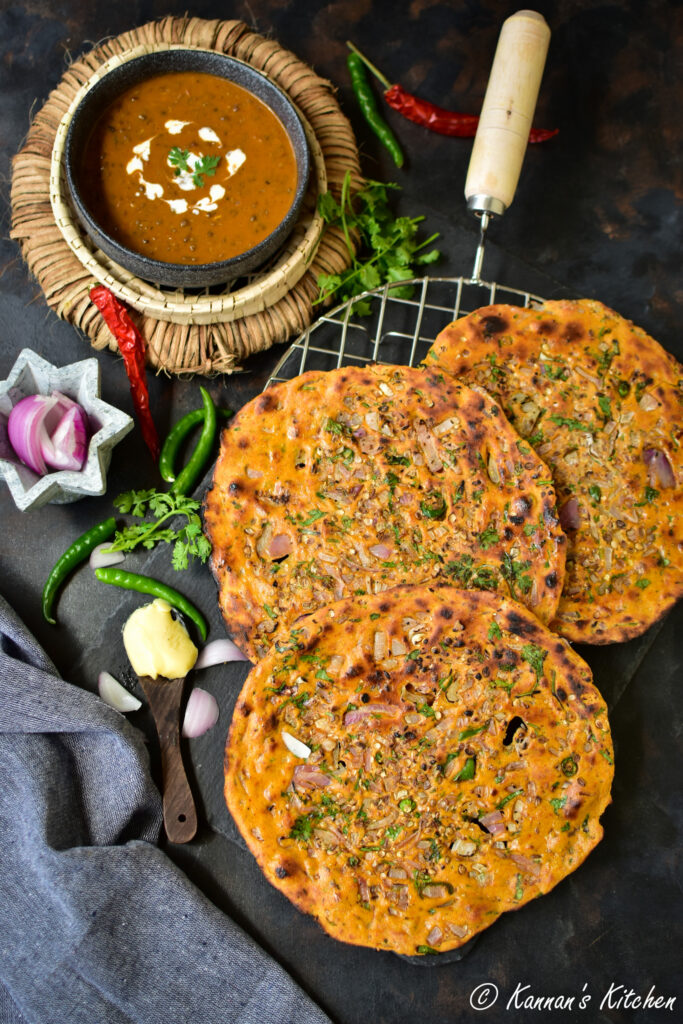
Tips for making a perfect Missi Roti:
One of the common issues faced by many while making this roti is that it tends to become hard or heavy. There is more than one reason for this – the main one being the ratio of the gram flour and wheat flour. Many recipes might call for use of only gram flour or use of a higher proportion of gram flour as compared to whole wheat flour. Besan tends to make the roti heavy, so I always prefer using a ratio of 1 portion of whole wheat flour and 0.5 portion of besan to get the perfect texture and crunch.
I also use a small amount of baking soda, baking powder and curd while kneading the dough for Missi roti, as the reaction between the curd and baking soda helps making the roti lighter and also get blisters on the rotis which you get in restaurants.
Missi roti tastes best when it is made in a tandoor. I have tried cooking Missi roti like a normal roti and it does not taste the same as you get in the dhabas or restaurants. We normally do not have tandoors at home, but in the below recipe I have given the steps and technique to get a perfect tandoori style missi roti. The cooking process is similar to the home-made Naan, all you need is a cooker or tawa which is not non-stick in nature.
While cooking missi roti in the above mentioned tandoor style, do not use oil for cooking as it would be cooked directly above flame on one side. However as soon as the roti is cooked, smear a generous amount of butter or ghee which would make it soft from one side and easy to eat as this roti is generally little dry by nature.
Onions add a great crunch and taste to missi roti, so I prefer to use a generous amount of chopped onions in the recipe. The onions need not be very finely chopped and it can be cut in a very rustic style. In addition to mixing onions with the dough, I also reserve half of the onions, fresh coriander leaves and coarsely crushed masala for the top coating on the roti.
Dry roast the coriander seeds and cumin on low flame and roughly crush them in the pestle and mortar. Adding this mixture to the roti dough would give a bite of these whole spices while eating and also enhance the flavour. Similarly, addition of carom seeds or ajwain not only adds to the taste but also aids in easy digestion, so do not skip this ingredient.
Lastly, do not roll the roti too thin or too thick either. If the roti is too thin, it would turn out crisp like a papad and at the same time if it is too thick, it might feel quite heavy. I add 2 tablespoons of ghee while kneading the dough to give the roti a nice flaky texture
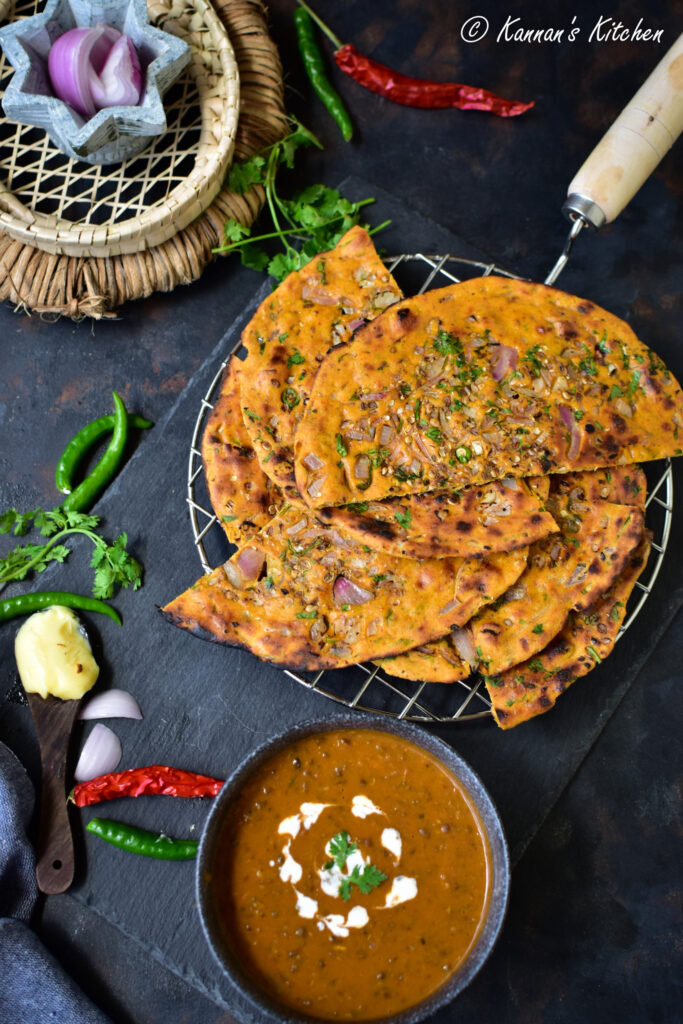
Serving Suggestion
Missi roti pairs well with most of the North Indian gravies including paneer and other veggies. However, the best side-dish for Missi roti is Dal Makhani or Dal Bukhara. Trust me this combination is a match made in heaven! Since missi roti is loaded with spices and onions, it just tastes great with simple curd and pickle too. However do not forget to brush the rotis with a generous amount of ghee or butter!
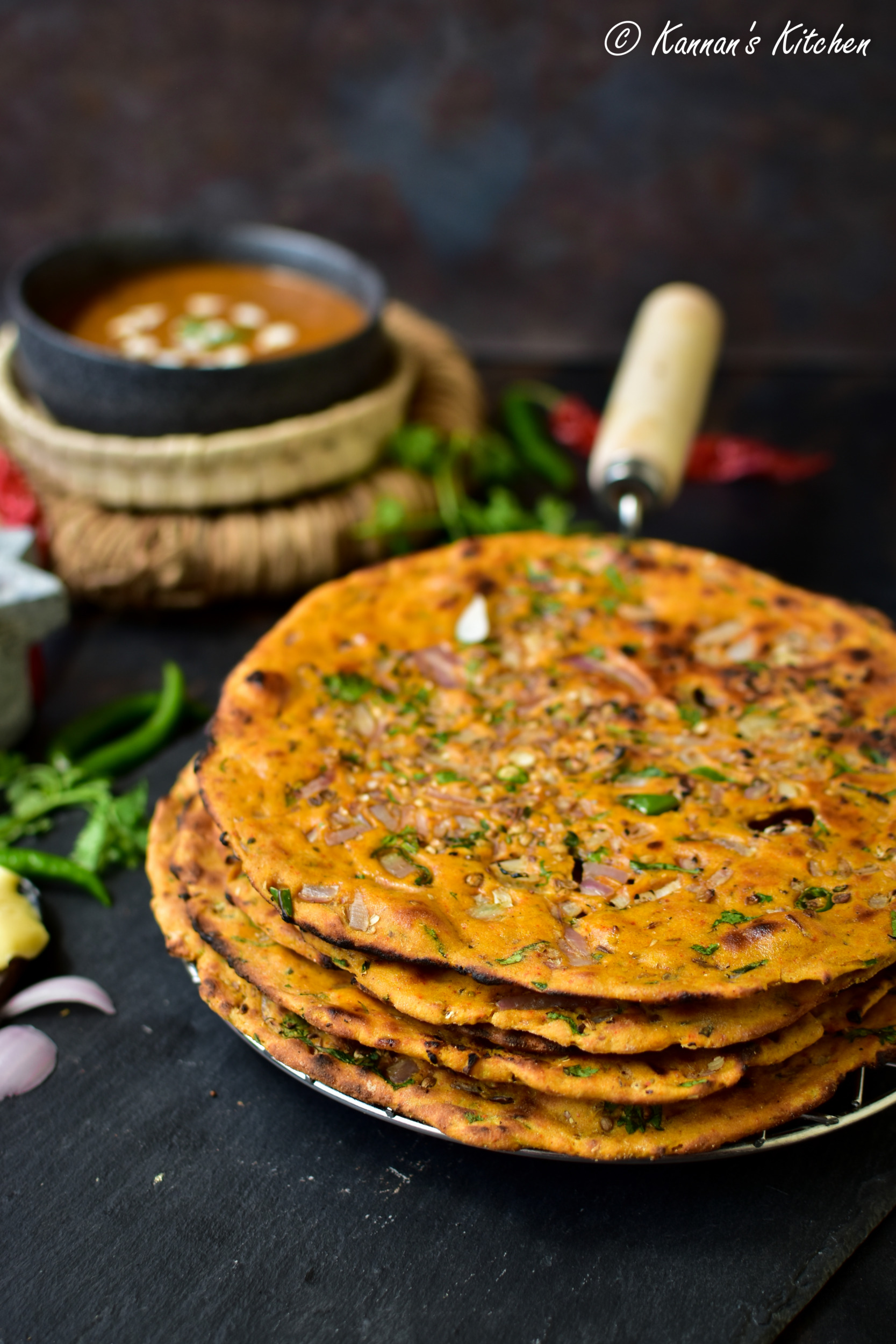
Missi Roti
Ingredients
- 1½ cup Whole Wheat Flour
- ¾ cup Besan or Gram Flour
- 2 tbsp Curd
- 2 tbsp Ghee
- 1 tsp Carom Seeds or Ajwain
- 2 tsp Kashmiri Red Chilli Powder
- 1 tsp Dhaniya or Coriander Powder
- 1 tsp Roasted Jeera Powder
- ⅛ tsp Asafoetida or Hing
- ½ tsp Baking Powder
- ¼ tsp Baking Soda
- 2 tsp Kasuri Methi
- 2 tsp Oil
- Water for kneading dough
- Butter or Ghee for greasing
- Salt to taste
For topping
- 2 large Onions roughly chopped
- 2 Green Chillies finely chopped
- 4-5 tbsp Coriander Leaves finely chopped
- 2 tbsp Coriander Seeds
- 1 tsp Cumin or Jeera
Instructions
- Roughly chop the onions. Chop the green chillies and coriander leaves finely.
- Dry roast the coriander seeds and cumin on low flame for one to two minutes till they turn aromatic.
- Roughly crush the roasted coriander seeds and cumin in a pestle and mortar.
- Now mix the crushed coriander and cumin seeds with the chopped onions, green chillies and coriander. Reserve half of this mixture separately which would be used for the topping while rolling the rotis.
- Mix all the other ingredients mentioned above and add the remaining half of the onion mixture and mix well. Add water little by little and knead to a medium firm dough. Note that the onion might release some water too, so be careful not to add too much water while kneading the dough. Finally add 2 teaspoon of oil and knead well.
- Cover this dough and let it rest for 20-30 minutes.
- Now take a medium portion ball of this dough and dust with flour and roll slightly.
- Place this roti over the reserved onion mix so that a good layer of onion is coated over the roti.
- Dust the roti and roll it slightly more. Make sure not to roll the roti too thin and at the same time it should not be too thick too.
- Now flip the roti with the onion side being down and apply a generous amount of water on the roti.
- Heat a tawa or a cooker which is NOT non-stick and put the roti with the water-side being down so that it sticks to the tawa well.
- Cook the roti on medium flame till you start seeing some bubbles or blisters on the roti. Do not apply any oil.
- Now flip the tawa over the gas stove. Do not keep it over the flame directly, but just above the flame and cook for 30 seconds to 1 minute or till it is well cooked.
- Remove the roti from the tawa and immediately grease with butter or ghee. Serve while it is hot.
Notes
- Use the wheat flour and gram flour in the ratio of 1: 1/2 for the perfect texture
- Adding ghee while kneading the dough gives it a good crispness on the bottom
- Baking soda and curd help in making the roti light
- Be cautious with the amount of water used while kneading, as onions tend to release water too.
- Do not use a non-stick tawa for cooking the roti, as the roti might not stick well
- Missi roti tastes best when it is served hot, so this dish might not be best for packed lunches
- Apply a generous amount of ghee or butter immediately after cooking
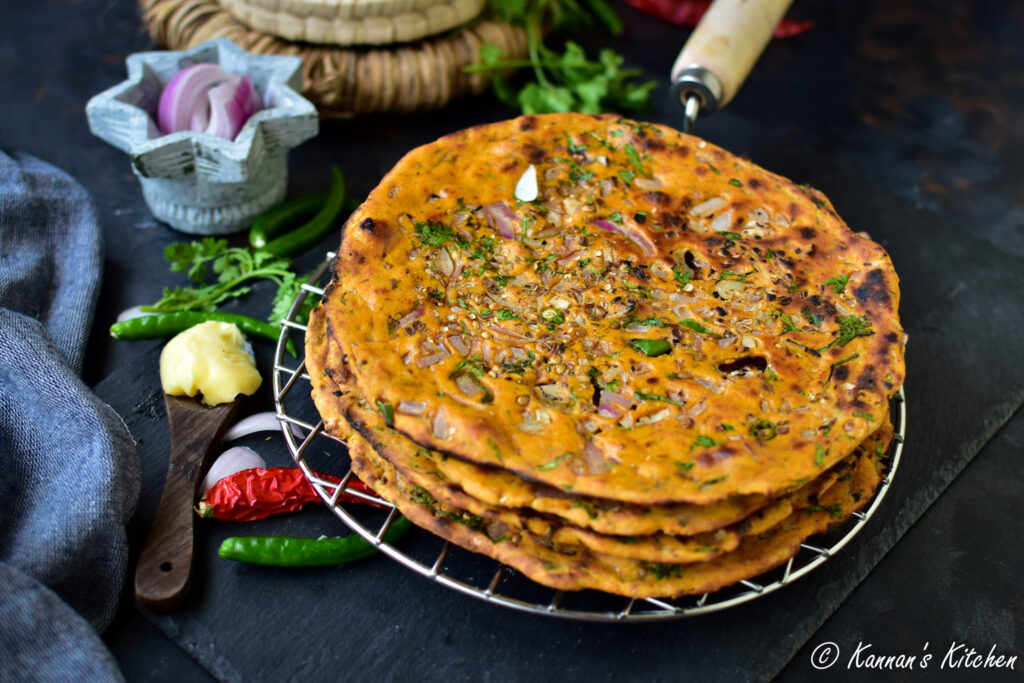

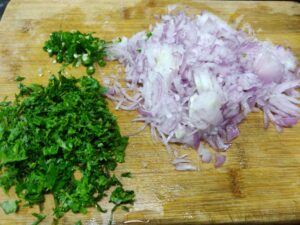



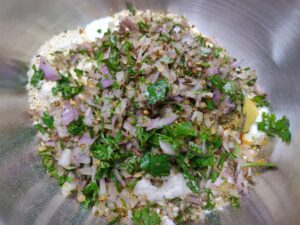
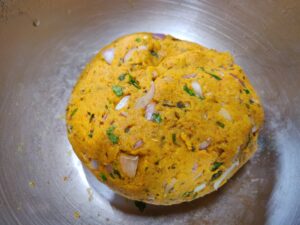
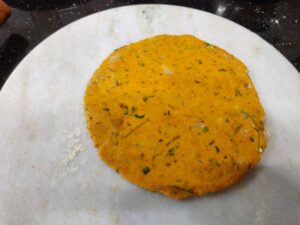


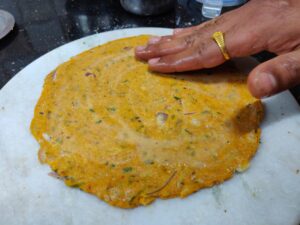
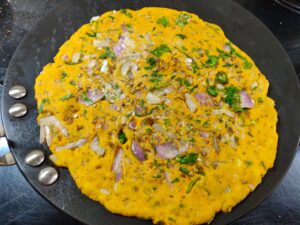
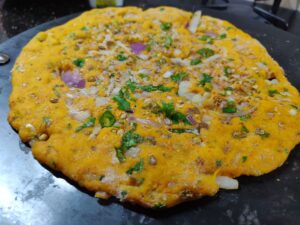
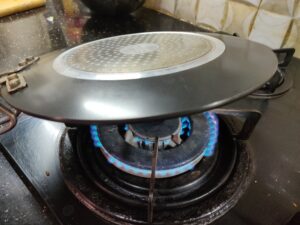

Everything is very open with a precise clarification of the challenges. It was really informative. Your website is useful. Thanks for sharing!
Thank you 🙂